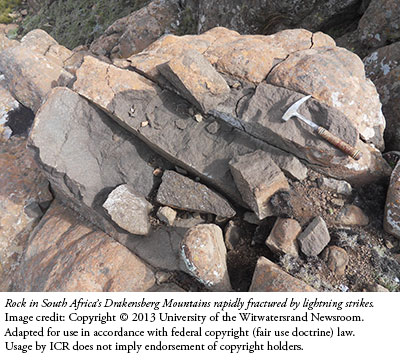Scientists recently studied the Drakensberg Range in South Africa, discovering that lightning likely damages mountain surfaces far more often than previously thought. Lightning also generates fulgarites, and these two finds call into question old age assignments for Earth's land features.
Publishing in the journal Geomorphology, Jasper Knight and Stefan Grab observed that just one lightning strike can gouge a huge divide through solid bedrock. Such a strike partially melts the rocks adjacent to cracks, causing the rock's magnetic minerals to reorient themselves to the direction of Earth's magnetic field. The Drakensberg Range contains basalt rocks, which have plenty of magnetic minerals oriented to the apparently different magnetic field lines present at the rocks' original formation. By passing a compass over the Drakensberg's cracks and watching its needle spin and flip, Knight and Grab determined that the fractures in question resulted from lightning.1
 The typical explanation for these fissures calls upon repeated wintry frost-wedging over supposed eons.1 But when this team mapped magnetic signatures, they found that summer lightning strikes caused more cracks across the mountains than ever suspected, leaving the freezing-waters explanation out in the cold.
The typical explanation for these fissures calls upon repeated wintry frost-wedging over supposed eons.1 But when this team mapped magnetic signatures, they found that summer lightning strikes caused more cracks across the mountains than ever suspected, leaving the freezing-waters explanation out in the cold.
According to Knight and Grab, "Many people have considered mountains to be pretty passive agents, just sitting there to be affected by cold climates over these long periods of time. This evidence suggests that that is completely wrong."2
How might this finding affect overall erosion rates estimated for entire continents? Geologists have studied erosion rates worldwide for decades. A 2011 meta study collated hundreds of data points, finding that land erodes on average at 40 feet every million years. At this rate, all continents reduce to sea level in only 50 million years—far too fast to accommodate the billion-year age assignments of so many exposed Earth rocks.3
But those studies never took into account these new lightning data, a factor which would only accelerate the erosion rate, making Earth's old age assignment even less credible.
Lightning-generated cracks may not be a well-known erosional process, but earth scientists are generally more familiar with fulgurites—long, branched tubes of quickly melted and re-solidified materials created when lightning strikes sand and other ground debris. Yet, Earth's surface does not display billions or even millions of years' worth of fulgarites.
Physicist Don DeYoung described this problem in the Spring 2013 issue of the Creation Research Society Quarterly: "With approximately one hundred lightning strokes [sic] per second occurring across the earth, throughout the alleged 4.6 billion years of earth history….there should be…more than 1,000 fulgurites per square meter of land everywhere."4 And this is if only "1% of these land strikes resulted in fulgurite formation."4
Where are all the missing fulgurites? Why are continents and high mountains still standing despite dramatic lightning damage and relatively fast erosion rates? The answers to these questions are the same—the world is only thousands, not billions, of years old.
References
- Knight, J. and S. W. Grab. Lightning as a geomorphic agent on mountain summits: Evidence from southern Africa. Geomorphology. Published online before print August 7, 2013.
- Foss, K. New evidence on lightning strikes. University of the Witwatersrand Newsroom. Posted on wits.ac.za October 15, 2013, accessed November 12, 2013.
- See Thomas, B. Continents Should Have Eroded Long Ago. Creation Science Update. Posted on icr.org August 22, 2011, accessed November 7, 2013.
- DeYoung, D. B. 2013. A Survey of Lightning. Creation Research Society Quarterly. 49 (4): 281-286.
* Mr. Thomas is Science Writer at the Institute for Creation Research.
Article posted on November 15, 2013.











